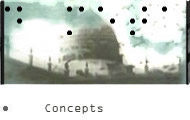Background - Aspects & Theory
When memories went to the movies
Since the advent of motion pictures an ever growing repository of life-like information became reality. Informational technology achieved to make large parts of literal information accesssible world-wide - though movies, TV and music remain untouched.
References to information in time-based media are still treated as references to a common remembrance of incidents. We have to have seen or listened to it to take part.
Our intention is to bring back the living details, not just photo and description.
Every mentionable detail represented by perceived incidents is a valuable source. At least as an anchor in time. These anchors bring up the possiblity to crawl large amounts of media in very short time. And keep in mind, media might not refer to reality at all, but references to media are part of our life.
Behind the scenes
We developed a system that keeps video as metadata of events rather than some primary media. Think of video as an arbitrary binary description, (i. e. a take while movie shooting, a movie release, any event that has been captured to video).
Any further descriptive or analytic metadata are related to the event and its index marks on tape or clip. Index marks are represented solely as clip information and timecode.
An aggregation layer will provide technical and very basic content categories. Further descriptive or analytic metadata is related to users/roles who add and refine index marks.
Users may feed in personalised information in freely attributable categories.




